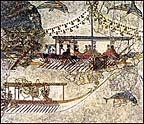 Dr. Floyd W. McCoy, a University of Hawaii geologist who has studied the eruption of Thera for decades has proposed that it was much more violent than previously thought. During a field trip to Anafi, an island some 20 miles east of Thera, he found fresh cut roads had exposed layers of Thera ash up to 10 feet thick. Factoring in such evidence, Dr. McCoy calculated that Thera had a V.E.I. of 7.0 — what geologists call colossal and exceedingly rare. In the past 10,000 years only one other volcano has exploded with that kind of gargantuan violence: Tambora, in Indonesia, in 1816, It produced an ash cloud in the upper atmosphere that reflected sunlight back into space and produced the year without a summer. The cold led to ruinous harvests, hunger and even famine in the United States, Europe and Russia.
Dr. Floyd W. McCoy, a University of Hawaii geologist who has studied the eruption of Thera for decades has proposed that it was much more violent than previously thought. During a field trip to Anafi, an island some 20 miles east of Thera, he found fresh cut roads had exposed layers of Thera ash up to 10 feet thick. Factoring in such evidence, Dr. McCoy calculated that Thera had a V.E.I. of 7.0 — what geologists call colossal and exceedingly rare. In the past 10,000 years only one other volcano has exploded with that kind of gargantuan violence: Tambora, in Indonesia, in 1816, It produced an ash cloud in the upper atmosphere that reflected sunlight back into space and produced the year without a summer. The cold led to ruinous harvests, hunger and even famine in the United States, Europe and Russia.
Dr. William B. F. Ryan, a geologist at Columbia's Lamont-Doherty Earth Observatory has woven such clues into a tantalizing but provisional theory on how distant effects might have slowly undone Crete. First, he noted that winds at low and high altitudes seem to have blown Thera's ash into distinct plumes — one to the southeast, toward Egypt and another heavier one to the northeast, toward Anatolia. Even if the changes wrought by Thera helped trees there, they apparently played havoc with delicate wheat fields.
Mursilis, a king of the Hittites, set out from Anatolia on a rampage, traveling between the plumes to strike Syria and Babylon and seize their stored grains and cereals. The subsequent collapse of Babylon into a dark age, Dr. Ryan said, also undid one of its puppets, the Hyksos, foreigners who ruled Egypt and traded with the Minoans.
He theorized that the new Egyptian dynasty had no love of Hyksos allies. So Minoan Crete, already reeling from Thera's fury, suffered new blows to its maritime trade.
No comments:
Post a Comment